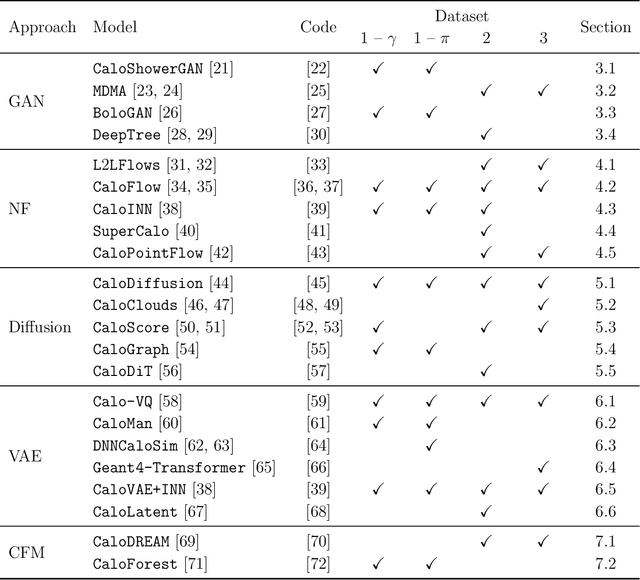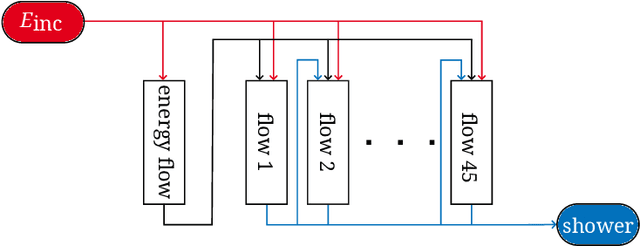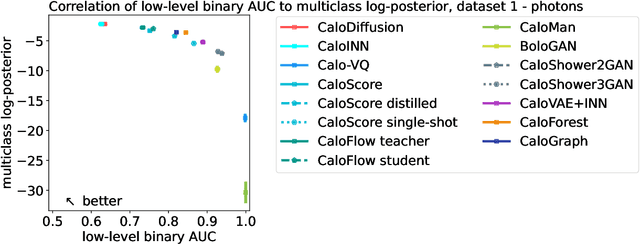Dirk Krücker
CaloChallenge 2022: A Community Challenge for Fast Calorimeter Simulation
Oct 28, 2024



Abstract:We present the results of the "Fast Calorimeter Simulation Challenge 2022" - the CaloChallenge. We study state-of-the-art generative models on four calorimeter shower datasets of increasing dimensionality, ranging from a few hundred voxels to a few tens of thousand voxels. The 31 individual submissions span a wide range of current popular generative architectures, including Variational AutoEncoders (VAEs), Generative Adversarial Networks (GANs), Normalizing Flows, Diffusion models, and models based on Conditional Flow Matching. We compare all submissions in terms of quality of generated calorimeter showers, as well as shower generation time and model size. To assess the quality we use a broad range of different metrics including differences in 1-dimensional histograms of observables, KPD/FPD scores, AUCs of binary classifiers, and the log-posterior of a multiclass classifier. The results of the CaloChallenge provide the most complete and comprehensive survey of cutting-edge approaches to calorimeter fast simulation to date. In addition, our work provides a uniquely detailed perspective on the important problem of how to evaluate generative models. As such, the results presented here should be applicable for other domains that use generative AI and require fast and faithful generation of samples in a large phase space.
DeepTreeGANv2: Iterative Pooling of Point Clouds
Nov 24, 2023Abstract:In High Energy Physics, detailed and time-consuming simulations are used for particle interactions with detectors. To bypass these simulations with a generative model, the generation of large point clouds in a short time is required, while the complex dependencies between the particles must be correctly modelled. Particle showers are inherently tree-based processes, as each particle is produced by the decay or detector interaction of a particle of the previous generation. In this work, we present a significant extension to DeepTreeGAN, featuring a critic, that is able to aggregate such point clouds iteratively in a tree-based manner. We show that this model can reproduce complex distributions, and we evaluate its performance on the public JetNet 150 dataset.
Physics Validation of Novel Convolutional 2D Architectures for Speeding Up High Energy Physics Simulations
May 19, 2021



Abstract:The precise simulation of particle transport through detectors remains a key element for the successful interpretation of high energy physics results. However, Monte Carlo based simulation is extremely demanding in terms of computing resources. This challenge motivates investigations of faster, alternative approaches for replacing the standard Monte Carlo approach. We apply Generative Adversarial Networks (GANs), a deep learning technique, to replace the calorimeter detector simulations and speeding up the simulation time by orders of magnitude. We follow a previous approach which used three-dimensional convolutional neural networks and develop new two-dimensional convolutional networks to solve the same 3D image generation problem faster. Additionally, we increased the number of parameters and the neural networks representational power, obtaining a higher accuracy. We compare our best convolutional 2D neural network architecture and evaluate it versus the previous 3D architecture and Geant4 data. Our results demonstrate a high physics accuracy and further consolidate the use of GANs for fast detector simulations.
Reduced Precision Strategies for Deep Learning: A High Energy Physics Generative Adversarial Network Use Case
Mar 18, 2021



Abstract:Deep learning is finding its way into high energy physics by replacing traditional Monte Carlo simulations. However, deep learning still requires an excessive amount of computational resources. A promising approach to make deep learning more efficient is to quantize the parameters of the neural networks to reduced precision. Reduced precision computing is extensively used in modern deep learning and results to lower execution inference time, smaller memory footprint and less memory bandwidth. In this paper we analyse the effects of low precision inference on a complex deep generative adversarial network model. The use case which we are addressing is calorimeter detector simulations of subatomic particle interactions in accelerator based high energy physics. We employ the novel Intel low precision optimization tool (iLoT) for quantization and compare the results to the quantized model from TensorFlow Lite. In the performance benchmark we gain a speed-up of 1.73x on Intel hardware for the quantized iLoT model compared to the initial, not quantized, model. With different physics-inspired self-developed metrics, we validate that the quantized iLoT model shows a lower loss of physical accuracy in comparison to the TensorFlow Lite model.
* Submitted at ICPRAM 2021; from CERN openlab - Intel collaboration
 Add to Chrome
Add to Chrome Add to Firefox
Add to Firefox Add to Edge
Add to Edge